Spatiotemporal Variation and Influencing Factors of Grain Yield in Major Grain-Producing Counties: A Comparative Study of Two Provinces from China
Abstract
:1. Introduction
2. Materials and Methods
2.1. Description of the Study Areas
2.2. Research Data
2.2.1. Database
2.2.2. Data Processing
2.3. Indicator System
2.4. Research Framework
2.5. Research Methods
2.5.1. Coefficient of Variation
2.5.2. Standard Deviation Ellipse
2.5.3. Exploratory Spatial Data Analysis (ESDA) Analysis
2.5.4. Geographical Detector
2.5.5. Geographically Weighted Regression (GWR)
3. Results
3.1. Temporal and Spatial Variation Characteristics of Grain Yield
3.1.1. Temporal Variation Characteristics
3.1.2. Spatial Variation Characteristics
3.1.3. Temporal and Spatial Evolution Trend
3.2. Spatial Correlation Analysis of Grain Yield
3.2.1. Spatial Autocorrelation Analysis
3.2.2. Local Spatial Autocorrelation Analysis
3.3. Analysis of Influencing Factors
3.3.1. Geographical Detector Analysis
3.3.2. Geographically Weighted Regression
4. Discussion
4.1. Spatiotemporal Characteristics of Grain Yield
- From the perspective of temporal changes, the total grain yield in Henan steadily increased, with only minor fluctuations, but the annual average growth rate and amount remained stable, which was similar to the traditional agricultural provinces of Shandong and Hunan in China [14,60]. The grain yield of Heilongjiang increased sharply, making it the province with a largest grain yield and a high annual growth rate, which was similar to the trend of Jilin and Liaoning Provinces in Northeast China [45]. In recent years, these regions experienced a drastic increase in grain yield, which played a prominent role in food security.
- There were some significant county-level differences. The grain yield in Henan generally showed a gradual increase from the west to the east, which was consistent with the overall distribution in China [15]. Many previous studies of China also showed this distribution pattern [49], so this may be a common phenomenon in most provinces of China. The grain yield of counties in Heilongjiang was relatively low in the eastern and western regions, with a high yield in the central and northern regions. The result was different from the distribution of most other provinces in China, demonstrating the unique spatial distribution of grain yield.
4.2. Influencing Factors of Grain Yield
- Factor input is the primary guarantee for grain yield. According to the results of geographic detectors and geographic weighted regression, the sown area of grain crops, the total power of agricultural machinery, the reduced net amount of fertilizer application, and the effective irrigation area all had a significant impact on the grain yield of the two provinces, which was consistent with the previous results [85,86,87,88,89,90]. Therefore, the primary prerequisite is to limit the non-agricultural and non-grain conversion of farmland, ensuring the sown area of grain crops. In addition, the investment in agricultural machinery, fertilizers, and irrigation was also important. The continuous popularization of agricultural machinery has not only reduced the cost of labor but also enabled intensive cultivation. Fertilizer can increase the grain yield by improving the required nutrients. The agricultural areas in China were mainly located in the monsoon areas, but the unstable precipitation left them prone to periodic droughts. In addition, improving the effective irrigation rate in agriculture was also a key factor in the increasing grain yield.
- The geographical environment is the foundation for the growth of food crops. The average annual temperature, annual precipitation, annual sunshine hours, and average slope also had a significant impact on the grain yield of the two provinces, which is a similar finding to existing research results [35,36,37,91]. A lower average annual temperature can make for a shorter growth period and frost, which has an adverse effect. Thus, the success of agriculture depends on the effective use of precipitation in irrigated farming areas, and the sunlight hours also affect the growth and quality of food crops by affecting plant photosynthesis.
- Socio-economics are an important driving force. The impact of per capita net income of farmers in Heilongjiang on grain yield was quite prominent, which was similar to the previous research results [31,32]. In Heilongjiang, the advantage of fewer people and more land led to a larger per capita arable land area, and rural laborers often choose to obtain a greater agricultural income. Therefore, the grain harvest and price rise can increase the agricultural income and enthusiasm, which further increase the sown area of grain crops, working to ensure national food security.
4.3. Recommendations
- Ensure the input of factors in the grain yield process. The planting area of grain crops has the greatest impact on grain yield, so a stable planting area is a key to ensuring grain yield. At the same time, the main focuses should be on increasing grain yield per unit area, introducing or cultivating high-quality grain varieties, promoting high-yield and high-density varieties, and utilizing agricultural technology to improve grain yield per unit area, especially in the large agricultural regions such as Henan and Heilongjiang. We need to increase the promotion of agricultural machinery, improve agricultural production efficiency, and reduce production costs. In addition, we can strengthen the construction of farmland water conservancy facilities that enhance the ability of the two provinces to resist drought and flood risks in agriculture, accelerate the development of high-standard farmland, strictly prevent the “cutting of green crops to destroy grain” of grain crops, and resolutely curb the “nonagricultural” farmland and “non-grain” agriculture.
- Promote agricultural modernization, intelligence, and digitization to develop smart agriculture. We need to strengthen meteorological monitoring of agricultural production and reduce the adverse effects of extreme weather on the growth of food crops. At the same time, we should strengthen the top-level design of smart agriculture, increase monitoring of agricultural diseases and pests, reduce labor costs through aerial spraying of pesticides and fertilizers, and improve intelligent control during the growth process of food crops. In addition, we can strengthen a series of services after grain production, build grain-drying facilities, provide grain storage facilities, solve sales difficulties, reduce the risks of food production in both pre- and post-production stages, and promote high-quality agricultural development.
- Ensure the income of grain farmers and mobilize their enthusiasm, reduce the cost of grain yield, and improve the mechanism for ensuring the income of grain farmers and compensating for the interests of main production areas. The government can regularly conduct outreach and training on agricultural planting, providing services such as agricultural supply, plant protection, and prevention, and improve planting skills and management capabilities. In addition, we can encourage various regions to develop the grain-processing industry according to local conditions, extend the industrial chain of agricultural production, promote the transformation and value-added of agricultural products, tap into the internal income potential of the grain industry, and fully mobilize the enthusiasm of farmers to increase the grain yield.
5. Conclusions
- There were significant differences in grain yield, annual growth rate, proportion in the country, and county-level production. The grain yield capacity of the two provinces gradually increased, and the annual average growth rate was higher than that of the whole country. The growth rate of the proportion of countrywide grain yield in Heilongjiang was greater than that in Henan. The county-level changes in grain yield of Henan remained stable, while the county-level differences in Heilongjiang gradually narrowed. The number of high-yield counties for grain yield significantly increased, and the spatial distribution of high-yield areas tends to be concentrated. The main areas of grain yield shifted significantly. The spatial distribution center of grain yield in Henan moved relatively little, while the distribution center of grain yield in Heilongjiang shifted significantly.
- The spatial correlation of grain yield was gradually increasing. The degree of spatial agglomeration was gradually strengthening, and the Global Moran’s index increased. Moran’s I value in Henan increased by a greater margin than that in Heilongjiang. Local spatial autocorrelation was mainly characterized by L-L and H-H clustering, and the number of counties in both types of clustering significantly increased. In addition, the spatial distribution range of H-H clustering areas in Heilongjiang changed significantly. The overall spatial pattern of grain yield in counties in Henan was stable, while the spatial pattern in Heilongjiang significantly changed.
- There were significant differences in the influencing factors of grain yield. Geographical environment, socio-economic factors, and factor inputs all had an impact on grain yield. Factor inputs had the greatest impact on grain yield, followed by geographical environment factors, and socio-economic factors had the smallest impact. The overall intensity of various factors in Henan Province was greater than that in Heilongjiang.
- The regional differences in the intensity of each influencing factor were significant. The intensity and direction of different influencing factors varied significantly. The sown area of grain crops, total power of agricultural machinery, reduced net amount of fertilizer application, and effective irrigation area all had a significant impact on grain yield, which was common to the two provinces. The annual sunshine hours and average slope had a significant impact in Henan, while the average annual temperature and per capita net income of farmers had a significant impact in Heilongjiang, which was a differential factor between the two provinces.
Author Contributions
Funding
Data Availability Statement
Acknowledgments
Conflicts of Interest
References
- Kairiza, T.; Kembo, G.; Magadzire, V.; Chigusiwa, L. Gender gap in the impact of social capital on household food security in Zimbabwe: Does spatial proximity matter? Rev. Econ. Househ. 2021, 21, 245–267. [Google Scholar] [CrossRef]
- Andrianarison, F. Unravelling the Linkage between Food Security, Poverty Reduction, and Education for Sustainable Development. J. Dev. Stud. 2022, 58, 2198–2221. [Google Scholar] [CrossRef]
- Niu, Y.; Xie, G.; Xiao, Y.; Liu, J.; Zou, H.; Qin, K.; Wang, Y.; Huang, M. The story of grain self-sufficiency: China’s food security and food for thought. Food Energy Secur. 2021, 11, e344. [Google Scholar] [CrossRef]
- Erokhin, V.; Gao, T.; Chivu, L.; Andrei, J.V. Food security in a food self-sufficient economy: A review of China’s ongoing transition to a zero hunger state. Agric. Econ. Czech. 2022, 68, 476–487. [Google Scholar] [CrossRef]
- Chen, L.; Huo, C. The Measurement and Influencing Factors of High-Quality Economic Development in China. Sustainability 2022, 14, 9293. [Google Scholar] [CrossRef]
- Hovhannisyan, V.; Devadoss, S. Effects of urbanization on food demand in China. Empir. Econ. 2020, 58, 699–721. [Google Scholar] [CrossRef]
- Zhu, S.; Kong, X.; Jiang, P. Identification of the human-land relationship involved in the urbanization of rural settlements in Wuhan city circle, China. J. Rural Stud. 2020, 77, 75–83. [Google Scholar] [CrossRef]
- Su, Y.; He, S.; Wang, K.; Shahtahmassebi, A.R.; Zhang, L.; Zhang, J.; Zhang, M.; Gan, M. Quantifying the sustainability of three types of agricultural production in China: An emergy analysis with the integration of environmental pollution. J. Clean. Prod. 2020, 252, 119650. [Google Scholar] [CrossRef]
- Bao, H.; Xu, Y.; Zhang, W.; Zhang, S. Has the monetary resettlement compensation policy hindered the two-way flow of resources between urban and rural areas? Land Use Policy 2020, 99, 104953. [Google Scholar] [CrossRef]
- Jiang, X.; Yin, G.; Lou, Y.; Xie, S.; Wei, W. The Impact of Transformation of Farmers’ Livelihood on the Increasing Labor Costs of Grain Plantation in China. Sustainability 2021, 13, 11637. [Google Scholar] [CrossRef]
- Gebeyehu, D.T.; East, L.; Wark, S.; Islam, M.S. Impact of COVID-19 on the food security and identifying the compromised food security dimension: A systematic review protocol. PLoS ONE 2023, 17, e0272859. [Google Scholar] [CrossRef] [PubMed]
- Falkendal, T.; Otto, C.; Schewe, J.; Jagermeyr, J.; Konar, M.; Kummu, M.; Watkins, B.; Puma, M.J. Grain export restrictions during COVID-19 risk food insecurity in many low- and middle-income countries. Nat. Food 2021, 2, 11–14. [Google Scholar] [CrossRef] [PubMed]
- Sharma, D.; Singh, A.; Kumar, A.; Mani, V.; Venkatesh, V.G. Reconfiguration of food grain supply network amidst COVID-19 outbreak: An emerging economy perspective. Ann. Oper. Res. 2021. [Google Scholar] [CrossRef] [PubMed]
- Cheng, J.; Yin, S. Quantitative Assessment of Climate Change Impact and Anthropogenic Influence on Crop Production and Food Security in Shandong, Eastern China. Atmosphere 2022, 13, 1160. [Google Scholar] [CrossRef]
- Li, S.; Zhang, D.; Xie, Y.; Yang, C. Analysis on the spatio-temporal evolution and influencing factors of China’s grain production. Environ. Sci. Pollut. Res. 2021, 29, 23834–23846. [Google Scholar] [CrossRef]
- Liu, Y.; Zhou, Y. Reflections on China’s food security and land use policy under rapid urbanization. Land Use Policy 2021, 109, 105699. [Google Scholar] [CrossRef]
- Wang, L.; Xiao, Y.; Ouyang, Z. Food and Grain Consumption Per Capita in the Qinghai-Tibet Plateau and Implications for Conservation. Nutrients 2021, 13, 3742. [Google Scholar] [CrossRef]
- Luo, Y.; Huang, D.; Wu, L.; Zhu, J. The impact of metal silos on rice storage and storage losses in China. Food Secur. 2021, 14, 81–92. [Google Scholar] [CrossRef]
- Luo, Y.; Huang, D.; Li, D.; Wu, L. On farm storage, storage losses and the effects of loss reduction in China. Resour. Conserv. Recycl. 2020, 162, 105062. [Google Scholar] [CrossRef]
- Luo, Y.; Huang, D.; Miao, H.; Wu, L.; Zhu, J. Impact of advanced storage facilities on households’ maize storage losses and food security in China. Environ. Dev. Sustain. 2021, 24, 221–237. [Google Scholar] [CrossRef]
- Xia, W.; Chen, X.; Song, C.; Perez-Carrera, A. Driving factors of virtual water in international grain trade: A study for belt and road countries. Agric. Water Manag. 2022, 262, 107441. [Google Scholar] [CrossRef]
- Du, R.; Chen, Y.; Dong, G.; Tian, L.; Zhang, J.; Zhang, N. Optimization and Benefit Analysis of Grain Trade in Belt and Road Countries. Entropy 2022, 24, 1667. [Google Scholar] [CrossRef] [PubMed]
- Amiri, S.; Eyni-Nargeseh, H.; Rahimi-Moghaddam, S.; Azizi, K. Water use efficiency of chickpea agro-ecosystems will be boosted by positive effects of CO2 and using suitable genotype x environment x management under climate change conditions. Agric. Water Manag. 2021, 252, 106928. [Google Scholar] [CrossRef]
- Janni, M.; Gulli, M.; Maestri, E.; Marmiroli, M.; Valliyodan, B.; Nguyen, H.T.; Marmiroli, N. Molecular and genetic bases of heat stress responses in crop plants and breeding for increased resilience and productivity. J. Exp. Bot. 2020, 71, 3780–3802. [Google Scholar] [CrossRef]
- Anghinoni, G.; Anghinoni, F.B.G.; Tormena, C.A.; Braccini, A.L.; Mendes, I.d.C.; Zancanaro, L.; Lal, R. Conservation agriculture strengthen sustainability of Brazilian grain production and food security. Land Use Policy 2021, 108, 105591. [Google Scholar] [CrossRef]
- Qi, X.; Li, J.; Yuan, W.; Wang, R.Y. Coordinating the food-energy-water nexus in grain production in the context of rural livelihood transitions and farmland resource constraints. Resour. Conserv. Recycl. 2021, 164, 105148. [Google Scholar] [CrossRef]
- Loko, Y.L.E.; Gbemavo, C.D.S.J.; Djedatin, G.; Ewedje, E.-E.; Orobiyi, A.; Toffa, J.; Tchakpa, C.; Sedah, P.; Sabot, F. Characterization of rice farming systems, production constraints and determinants of adoption of improved varieties by smallholder farmers of the Republic of Benin. Sci. Rep. 2022, 12, 3959. [Google Scholar] [CrossRef] [PubMed]
- Takeshima, H.; Hatzenbuehler, P.L.; Edeh, H.O. Effects of agricultural mechanization on economies of scope in crop production in Nigeria. Agric. Syst. 2020, 177, 102691. [Google Scholar] [CrossRef]
- Kakar, K.; Xuan, T.D.; Noori, Z.; Aryan, S.; Gulab, G. Effects of Organic and Inorganic Fertilizer Application on Growth, Yield, and Grain Quality of Rice. Agriculture 2020, 10, 544. [Google Scholar] [CrossRef]
- Malalgoda, M.; Simsek, S. Pesticide residue in grain-based food: Effects on health, grain quality, and chemical properties of biomacromolecules. Cereal Chem. 2020, 98, 8–16. [Google Scholar] [CrossRef]
- Wang, C.; Deng, M.; Deng, J. Factor reallocation and structural transformation implications of grain subsidies in China. J. Asian Econ. 2020, 71, 101248. [Google Scholar] [CrossRef]
- Baig, I.A.; Irfan, M.; Salam, M.A.; Isik, C. Addressing the effect of meteorological factors and agricultural subsidy on agricultural productivity in India: A roadmap toward environmental sustainability. Environ. Sci. Pollut. Res. 2022, 30, 15881–15898. [Google Scholar] [CrossRef] [PubMed]
- Huang, H.; Hou, M.; Yao, S. Urbanization and Grain Production Pattern of China: Dynamic Effect and Mediating Mechanism. Agriculture 2022, 12, 539. [Google Scholar] [CrossRef]
- Soma, K.; Hennen, W.; van Berkum, S. Can Domestic Food Production Provide Future Urban Populations with Food and Nutrition Security?-Insights from Bangladesh, Kenya and Uganda. Sustainability 2023, 15, 9005. [Google Scholar] [CrossRef]
- Ha, T.T.V.; Faiz, M.A.; Shuang, L. Assessment of the response of climate variability and price anomalies to grain yield and land use in Northeast China. Environ. Sci. Pollut. Res. 2021, 28, 36559–36572. [Google Scholar] [CrossRef] [PubMed]
- Pickson, R.B.; He, G.; Ntiamoah, E.B.; Li, C. Cereal production in the presence of climate change in China. Environ. Sci. Pollut. Res. 2020, 27, 45802–45813. [Google Scholar] [CrossRef]
- Osman, R.; Ata-Ul-Karim, S.T.; Tahir, M.N.; Ishaque, W.; Xu, M. Multi-model ensembles for assessing the impact of future climate change on rainfed wheat productivity under various cultivars and nitrogen levels. Eur. J. Agron. 2022, 139, 126554. [Google Scholar] [CrossRef]
- Manavalan, R. Automatic identification of diseases in grains crops through computational approaches: A review. Comput. Electron. Agric. 2020, 178, 105802. [Google Scholar] [CrossRef]
- Huang, Z.; Wang, C.; Li, Y.; Zhang, H.; Zeng, A.; He, X. Field evaluation of spray drift and nontargeted soybean injury from unmanned aerial spraying system herbicide application under acceptable operation conditions. Pest Manag. Sci. 2022, 79, 1140–1153. [Google Scholar] [CrossRef]
- Fan, J.; Lu, X.; Gu, S.; Guo, X. Improving nutrient and water use efficiencies using water-drip irrigation and fertilization technology in Northeast China. Agric. Water Manag. 2020, 241, 106352. [Google Scholar] [CrossRef]
- Finch, B.A.; Reed, V.T.; Williams, J.E.; Sharry, R.L.; Arnall, D.B. Impact of in-furrow fertilizers on winter wheat grain yield and mineral concentration. J. Agric. Sci. 2022, 160, 493–501. [Google Scholar] [CrossRef]
- Ren, A.; Jiang, D.; Kang, M.; Wu, J.; Xiao, F.; Hou, P.; Fu, X. Evaluation of an intelligent artificial climate chamber for high-throughput crop phenotyping in wheat. Plant Methods 2022, 18, 77. [Google Scholar] [CrossRef] [PubMed]
- Zhang, Q.; Zhang, F.; Wu, G.; Mai, Q. Spatial spillover effects of grain production efficiency in China: Measurement and scope. J. Clean. Prod. 2020, 278, 121062. [Google Scholar] [CrossRef]
- Zhang, J.; Fang, Y.; Zheng, H.; Fan, S.; Du, T. The Spatio-Temporal Evolution of Food Production and Self-Sufficiency in China from 1978 to 2020: From the Perspective of Calories. Foods 2023, 12, 956. [Google Scholar] [CrossRef] [PubMed]
- Xin, F.; Xiao, X.; Dong, J.; Zhang, G.; Zhang, Y.; Wu, X.; Li, X.; Zou, Z.; Ma, J.; Du, G.; et al. Large increases of paddy rice area, gross primary production, and grain production in Northeast China during 2000–2017. Sci. Total Environ. 2020, 711, 135183. [Google Scholar] [CrossRef]
- He, H.; Ding, R.; Tian, X. Spatiotemporal characteristics and infuencing factors of grain yield at the county level in Shandong Province, China. Sci. Rep. 2022, 12, 12001. [Google Scholar] [CrossRef]
- Wang, J.; Tian, G.; Tao, Y.; Lu, C. Prediction of Chongqing’s grain output based on support vector machine. Front. Sustain. Food Syst. 2023, 7, 1015016. [Google Scholar] [CrossRef]
- Li, H.; Dai, D. The Integration of Urban and Rural Development in Country: How to Make It Possible and What to Do. J. Nanjing Agric. Univ. 2023, 23, 21–31. [Google Scholar] [CrossRef]
- Chandio, A.A.; Dash, D.P.; Nathaniel, S.P.; Sargani, G.R.; Jiang, Y. Mitigation pathways towards climate change: Modelling the impact of climatological factors on wheat production in top six regions of China. Ecol. Model. 2023, 481, 110381. [Google Scholar] [CrossRef]
- Wang, Z.; Lv, D. Analysis of Agricultural CO2 Emissions in Henan Province, China, Based on EKC and Decoupling. Sustainability 2022, 14, 1931. [Google Scholar] [CrossRef]
- Li, X.; Shang, J. Decision-Making Behavior of Fertilizer Application of Grain Growers in Heilongjiang Province from the Perspective of Risk Preference and Risk Perception. Math. Probl. Eng. 2021, 2021, 6667558. [Google Scholar] [CrossRef]
- Chen, W.; Bai, Y.; Li, B.; Feng, C.; Zhou, M. Analysis of Water Environment Quality Changes and Influencing Factors during the “Thirteenth Five-Year Plan” Period in Heilongjiang Province. Water 2022, 14, 2367. [Google Scholar] [CrossRef]
- Ha, T.T.V.; Fan, H.; Shuang, L. Climate change impact assessment on Northeast China’s grain production. Environ. Sci. Pollut. Res. 2020, 28, 14508–14520. [Google Scholar] [CrossRef] [PubMed]
- Leuthold, S.J.; Wendroth, O.; Salmeron, M.; Poffenbarger, H. Weather-dependent relationships between topographic variables and yield of maize and soybean. Field Crops Res. 2021, 276, 108368. [Google Scholar] [CrossRef]
- Mubai, N.; Sibiya, J.; Mwololo, J.; Musvosvi, C.; Charlie, H.; Munthali, W.; Kachulu, L.; Okori, P. Phenotypic correlation, path coefficient and multivariate analysis for yield and yield-associated traits in groundnut accessions. Cogent Food Agric. 2020, 6, 1823591. [Google Scholar] [CrossRef]
- Mohammadi, R.; Amri, A. Assessment of the suitability of Triticum turgidum accessions for incorporation into a durum wheat breeding program. Euphytica 2022, 218, 70. [Google Scholar] [CrossRef]
- Genievskaya, Y.; Almerekova, S.; Abugalieva, S.; Abugalieva, A.; Sato, K.; Turuspekov, Y. Identification of SNPs Associated with Grain Quality Traits in Spring Barley Collection Grown in Southeastern Kazakhstan. Agronomy 2023, 13, 1560. [Google Scholar] [CrossRef]
- Yang, Q.; Zheng, J.; Zhu, H. Influence of spatiotemporal change of temperature and rainfall on major grain yields in southern Jiangsu Province, China. Glob. Ecol. Conserv. 2020, 21, e00818. [Google Scholar] [CrossRef]
- Bozorg-Haddad, O.; Sohrabi, S.; Delpasand, M.; Loaiciga, H.A. Dryland farming improvement by considering the relation between rainfall variability and crop yield. Environ. Dev. Sustain. 2020, 23, 5316–5327. [Google Scholar] [CrossRef]
- Yu, D.; Hu, S.; Tong, L.; Xia, C.; Ran, P. Dynamics and Determinants of the Grain Yield Gap in Major Grain-Producing Areas: A Case Study in Hunan Province, China. Foods 2022, 11, 1122. [Google Scholar] [CrossRef]
- Ajami, M.; Heidari, A.; Khormali, F.; Zeraatpisheh, M.; Gorji, M.; Ayoubi, S. Spatial Variability of Rainfed Wheat Production Under the Influence of Topography and Soil Properties in Loess-Derived Soils, Northern Iran. Int. J. Plant Prod. 2020, 14, 597–608. [Google Scholar] [CrossRef]
- Lu, H.; Huan, H. Does the transfer of agricultural labor reduce China’s grain output? A substitution perspective of chemical fertilizer and agricultural machinery. Front. Environ. Sci. 2022, 10, 961648. [Google Scholar] [CrossRef]
- Lei, C.; Qi, Q.; Fu, Y.; Jiang, L.; Liang, Q. Analysis on Mechanism of China’s Grain Production Development and Evolution From 1985 to 2019. IEEE Access 2022, 10, 43221–43234. [Google Scholar] [CrossRef]
- Qian, J.; Ito, S.; Zhao, Z. The effect of price support policies on food security and farmers’ income in China. Aust. J. Agric. Resour. Econ. 2020, 64, 1328–1349. [Google Scholar] [CrossRef]
- Otegui, M.E.; Riglos, M.; Mercau, J.L. Genetically modified maize hybrids and delayed sowing reduced drought effects across a rainfall gradient in temperate Argentina. J. Exp. Bot. 2021, 72, 5180–5188. [Google Scholar] [CrossRef]
- Liu, X.; Li, X. The Influence of Agricultural Production Mechanization on Grain Production Capacity and Efficiency. Processes 2023, 11, 487. [Google Scholar] [CrossRef]
- Sun, Z.; Li, X. Technical Efficiency of Chemical Fertilizer Use and Its Influencing Factors in China’s Rice Production. Sustainability 2021, 13, 1155. [Google Scholar] [CrossRef]
- Bai, M.; Zhou, S.; Tang, T. A Reconstruction of Irrigated Cropland Extent in China from 2000 to 2019 Using the Synergy of Statistics and Satellite-Based Datasets. Land 2022, 11, 1686. [Google Scholar] [CrossRef]
- Shahzad, U.; Ahmad, I.; Garcia-Luengo, A.V.; Zaman, T.; Al-Noor, N.H.; Kumar, A. Estimation of Coefficient of Variation Using Calibrated Estimators in Double Stratified Random Sampling. Mathematics 2023, 11, 252. [Google Scholar] [CrossRef]
- Araujo, J.A.; Pecanha, T.; Novelli, F.I.; Aleixes, M.C.S.; Moreira-Goncalves, D.; Arsa, G.; Cambri, L.T. Reproducibility of Heart Rate Variability Indices at Post-maximal Exercise. Int. J. Sports Med. 2020, 41, 512–519. [Google Scholar] [CrossRef]
- Zhang, E.; Wang, Z.; Chen, G.; Wang, G.; Zhou, Y.; Hu, P.; Zhao, H. Spatial-Temporal Evolution Patterns and Influencing Factors of Hotels in Yellow River Basin from 2012 to 2022. Land 2023, 12, 770. [Google Scholar] [CrossRef]
- Laguillo, M.; Segarra, P.; Sanchidrian, J.A.; Beitia, F. A novel borehole surveying system for underground mining: Design and performance assessment. Measurement 2022, 194, 111021. [Google Scholar] [CrossRef]
- Kim, D. Exploratory study on the spatial relationship between emerging infectious diseases and urban characteristics: Cases from Korea. Sustain. Cities Soc. 2021, 66, 102672. [Google Scholar] [CrossRef] [PubMed]
- Liu, K.; Liu, W.; Wu, J.; Chen, Z.; Zhang, W.; Liu, F. Spatial Differences and Influencing Factors of Urban Water Utilization Efficiency in China. Front. Environ. Sci. 2022, 10, 890187. [Google Scholar] [CrossRef]
- Peter, P.O.; Rashid, A.; Nkinahamira, F.; Wang, H.; Wang, Q.; Gad, M.; Yu, C.; Hu, A. Integrated assessment of major and trace elements in surface and core sediments from an urban lagoon, China: Potential ecological risks and influencing factors. Mar. Pollut. Bull. 2021, 170, 112651. [Google Scholar] [CrossRef]
- Razavi-Termeh, S.V.; Sadeghi-Niaraki, A.; Seo, M.B.; Choi, S.-M. Application of genetic algorithm in optimization parallel ensemble-based machine learning algorithms to flood susceptibility mapping using radar satellite imagery. Sci. Total Environ. 2023, 873, 162285. [Google Scholar] [CrossRef]
- Tasyurek, M.; Celik, M. RNN-GWR: A geographically weighted regression approach for frequently updated data. Neurocomputing 2020, 399, 258–270. [Google Scholar] [CrossRef]
- Dubois, E.; Larocque, M.; Brunner, P. Impact of land cover changes on Long-Term Regional-Scale groundwater recharge simulation in cold and humid climates. Hydrol. Process. 2023, 37, e14810. [Google Scholar] [CrossRef]
- Zheng, W.; Liu, C.; Xin, Z.; Wang, Z. Flood and waterlogging monitoring over Huaihe River Basin by AMSR-E data analysis. Chin. Geogr. Sci. 2008, 18, 262–267. [Google Scholar] [CrossRef]
- Guo, X.; Cheng, J.; Yin, C.; Li, Q.; Chen, R.; Fang, J. The extraordinary Zhengzhou flood of 7/20, 2021: How extreme weather and human response compounding to the disaster. Cities 2022, 134, 104168. [Google Scholar] [CrossRef]
- Wu, L.; Zhang, Y.; Wang, L.; Xie, W.; Song, L.; Zhang, H.; Bi, H.; Zheng, Y.; Zhang, Y.; Zhang, X.; et al. Analysis of 22-year Drought Characteristics in Heilongjiang Province Based on Temperature Vegetation Drought Index. Comput. Intell. Neurosci. 2022, 2022, 1003243. [Google Scholar] [CrossRef] [PubMed]
- Echarte, L.; Alfonso, C.S.; Gonzalez, H.; Hernandez, M.D.; Lewczuk, N.A.; Nagore, L.; Echarte, M.M. Influence of management practices on water-related grain yield determinants. J. Exp. Bot. 2023, 74, 4825–4846. [Google Scholar] [CrossRef] [PubMed]
- Chandio, A.A.; Jiang, Y.; Amin, A.; Akram, W.; Ozturk, I.; Sinha, A.; Ahmad, F. Modeling the impact of climatic and non-climatic factors on cereal production: Evidence from Indian agricultural sector. Environ. Sci. Pollut. Res. 2021, 29, 14634–14653. [Google Scholar] [CrossRef] [PubMed]
- Mitura, K.; Cacak-Pietrzak, G.; Feledyn-Szewczyk, B.; Szablewski, T.; Studnicki, M. Yield and Grain Quality of Common Wheat (Triticum aestivum L.) Depending on the Different Farming Systems (Organic vs. Integrated vs. Conventional). Plants 2023, 12, 1022. [Google Scholar] [CrossRef] [PubMed]
- Yan, Y.; Cen, Y.; Zhang, P.; Zhang, Y. Analysis of Spatio-Temporal Changes of Grain Yield in Henan Province Based on SFA Model. Chin. J. Agric. Resour. Reg. Plan. 2020, 41, 76–86. [Google Scholar]
- Liu, H.; Wu, K.; Song, W.; Hu, Q.; Liu, H. Study on The Grain Productivity and its Influencing Factors in Heilongjiang. Chin. J. Agric. Resour. Reg. Plan. 2019, 40, 164–170. [Google Scholar]
- Yuan, Y.; Cao, Z.; Chen, Y.; Gong, P.; Huang, G.; He, L. Efficiency Analysis of the Crop Production in China in 2019 and 2020: Role of Uncertainty Perceptions in COVID-19. Discret. Dyn. Nat. Soc. 2022, 2022, 7044474. [Google Scholar] [CrossRef]
- Ma, P.; Wu, D.; Lin, T.; Wu, Z.; Li, Z.; Liang, Y.; Zhang, Y.; Lai, H. Spatio-Temporal Coupling Relationship between Rural Population and Cultivated Land Changes at the County Level in Guangdong Province. Sustainability 2022, 14, 14929. [Google Scholar] [CrossRef]
- Valojai Seyed, T.S.; Niknejad, Y.; Amoli, H.F.; Tari, D.B. Response of rice yield and quality to nano-fertilizers in comparison with conventional fertilizers. J. Plant Nutr. 2021, 44, 1971–1981. [Google Scholar] [CrossRef]
- Ju, Q.; Du, L.; Liu, C.; Jiang, S. Water resource management for irrigated agriculture in China: Problems and prospects. Irrig. Drain. 2023, 72, 854–863. [Google Scholar] [CrossRef]
- Tan, Q.; Liu, Y.; Dai, L.; Pan, T. Shortened key growth periods of soybean observed in China under climate change. Sci. Rep. 2021, 11, 8197. [Google Scholar] [CrossRef] [PubMed]
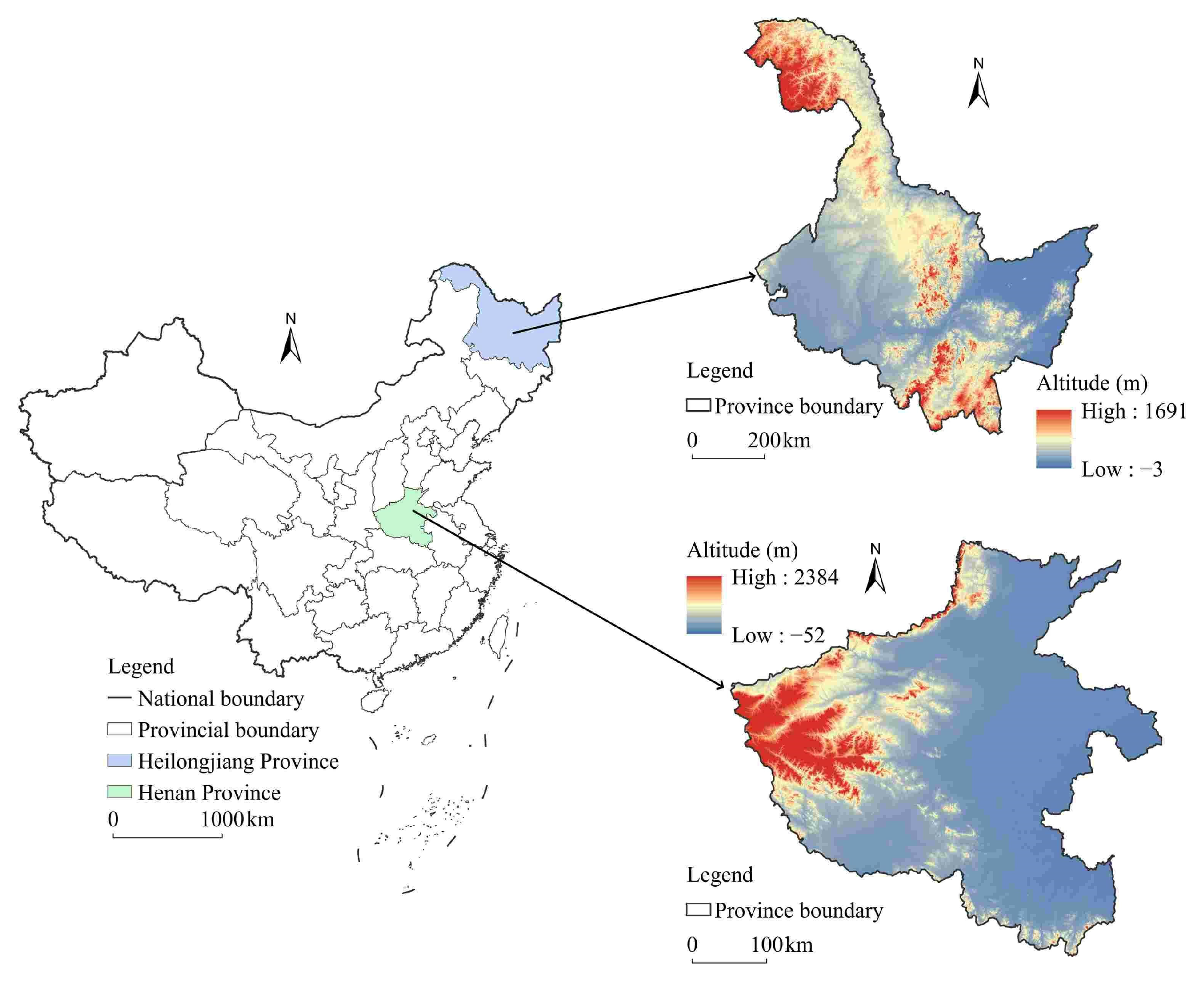
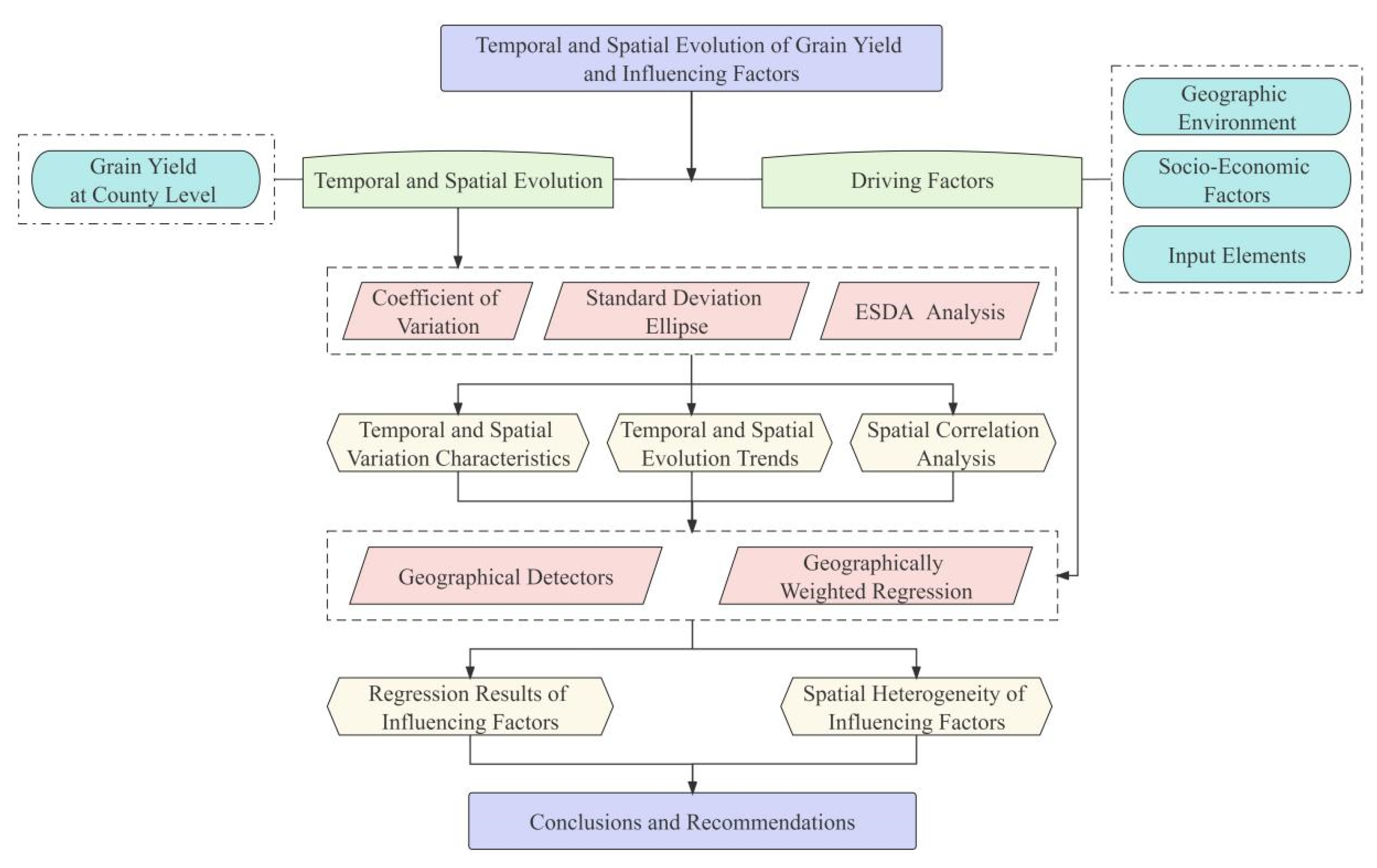


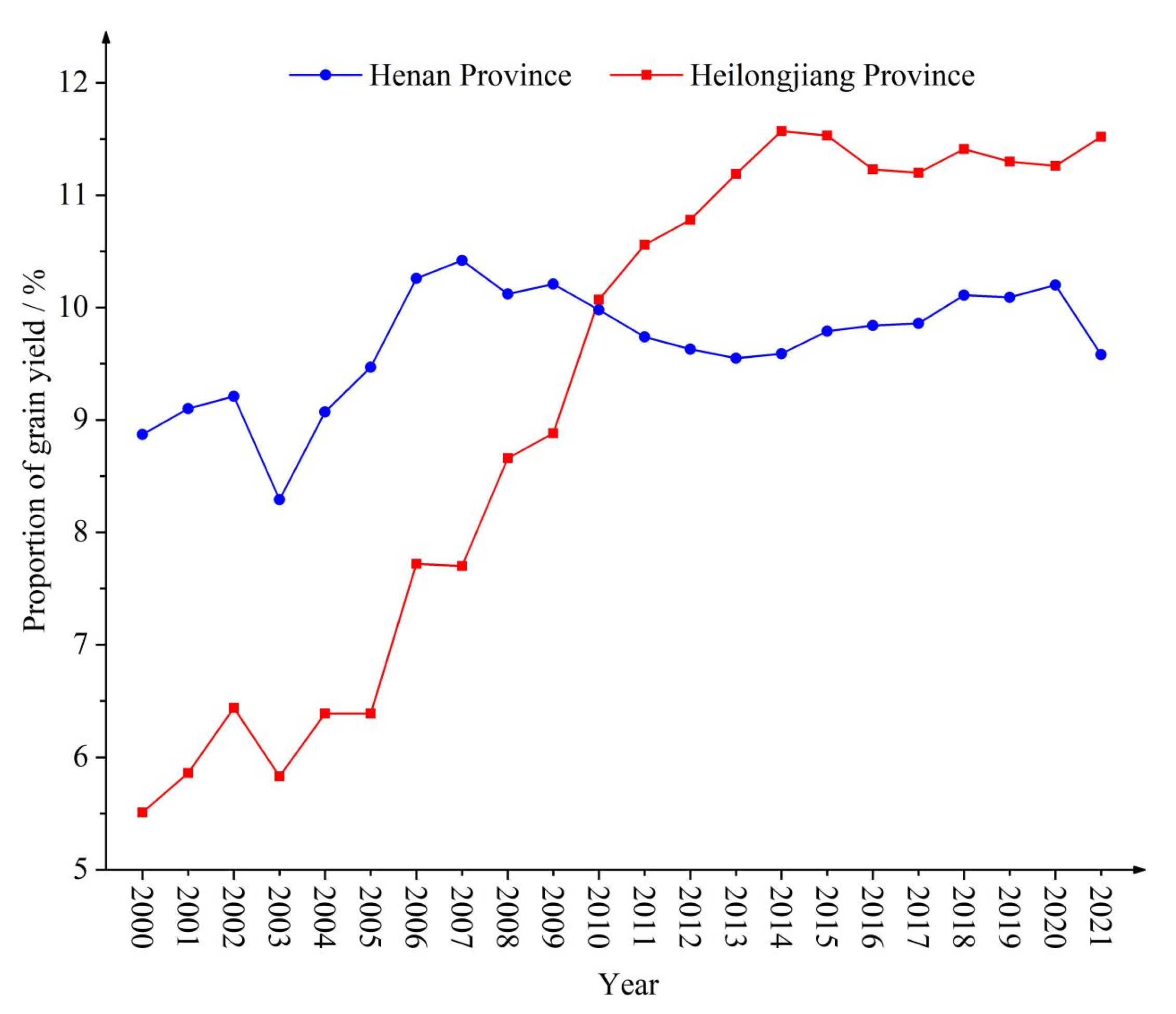
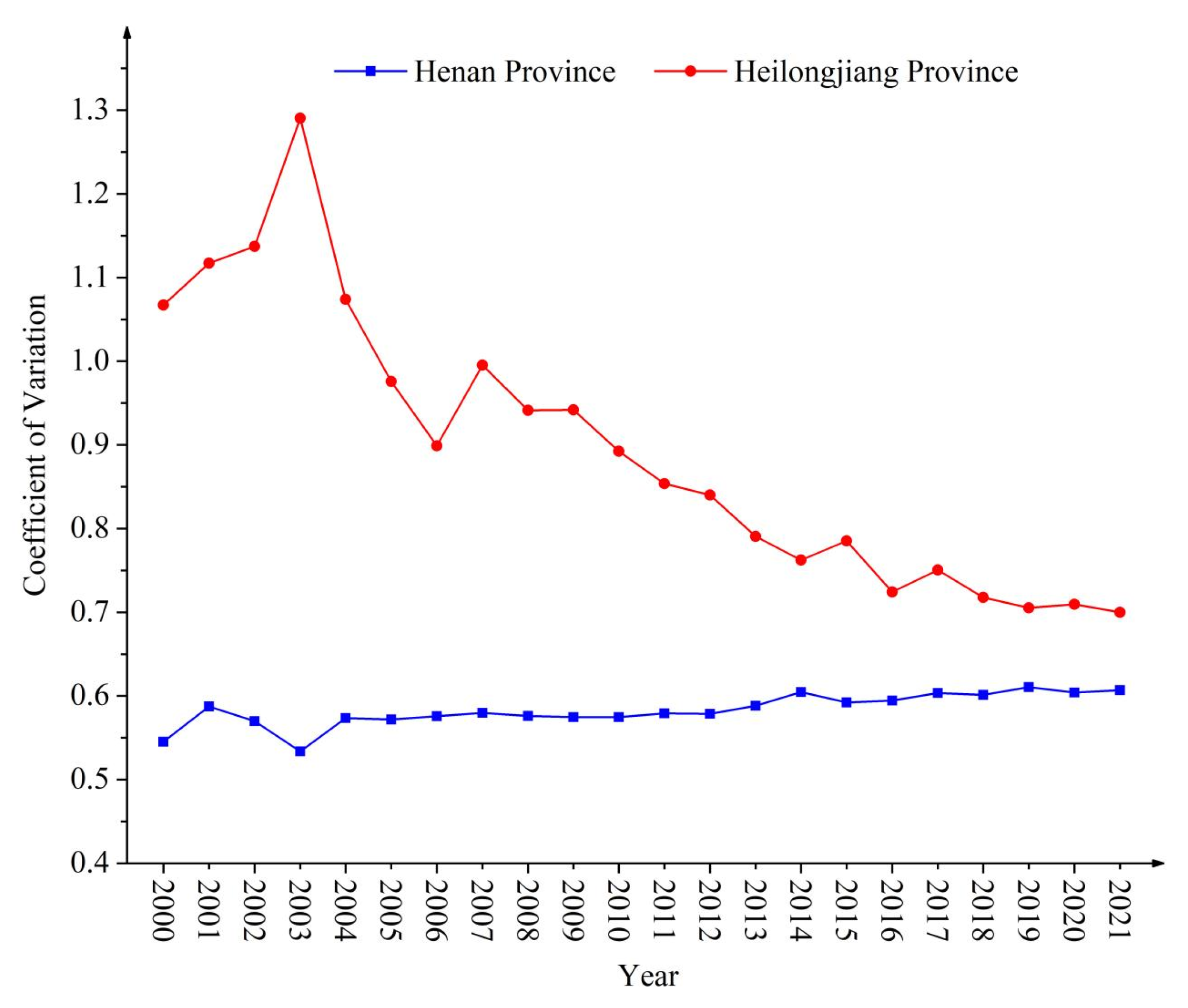
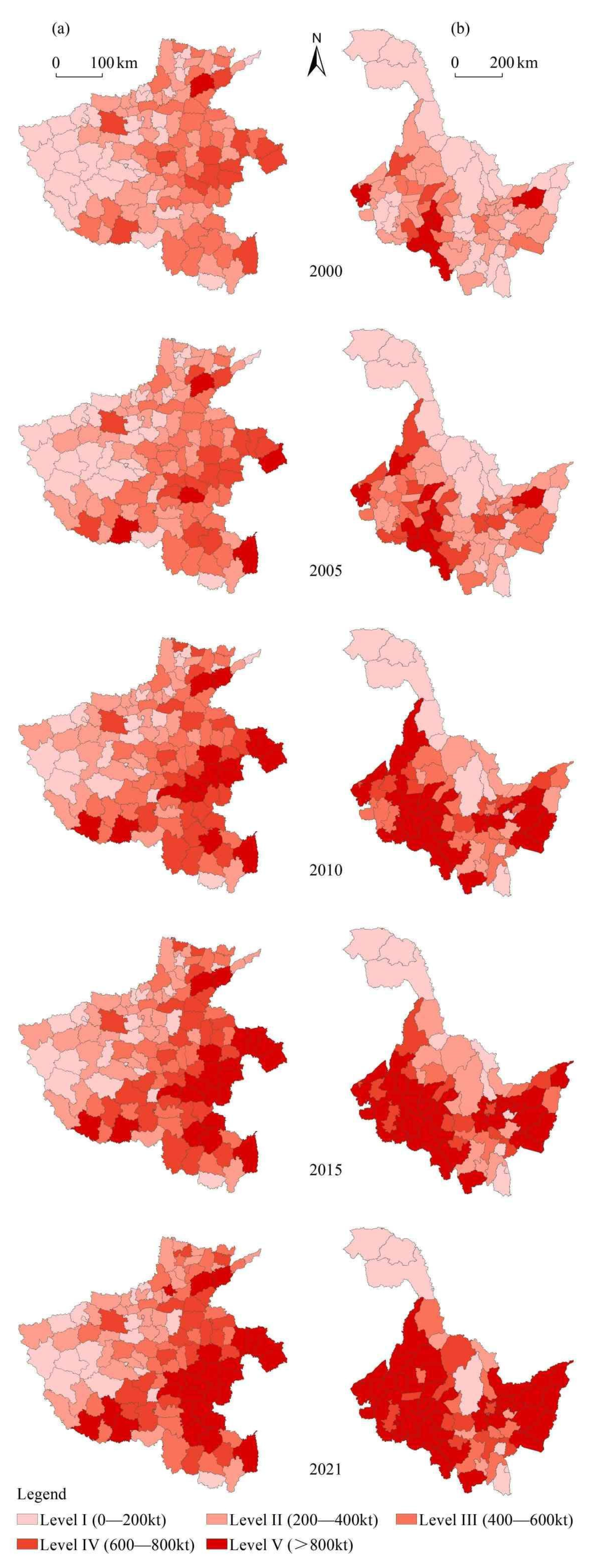
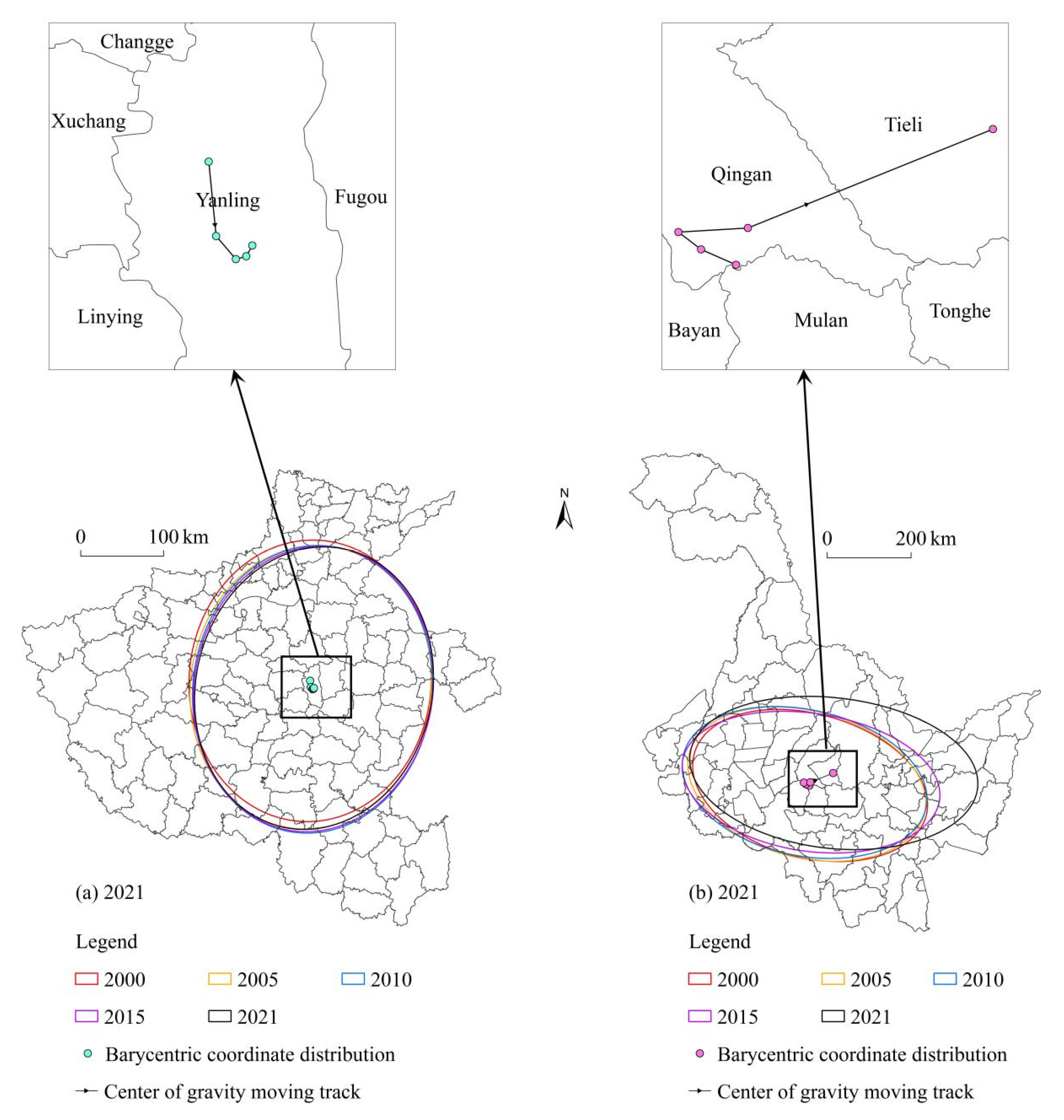
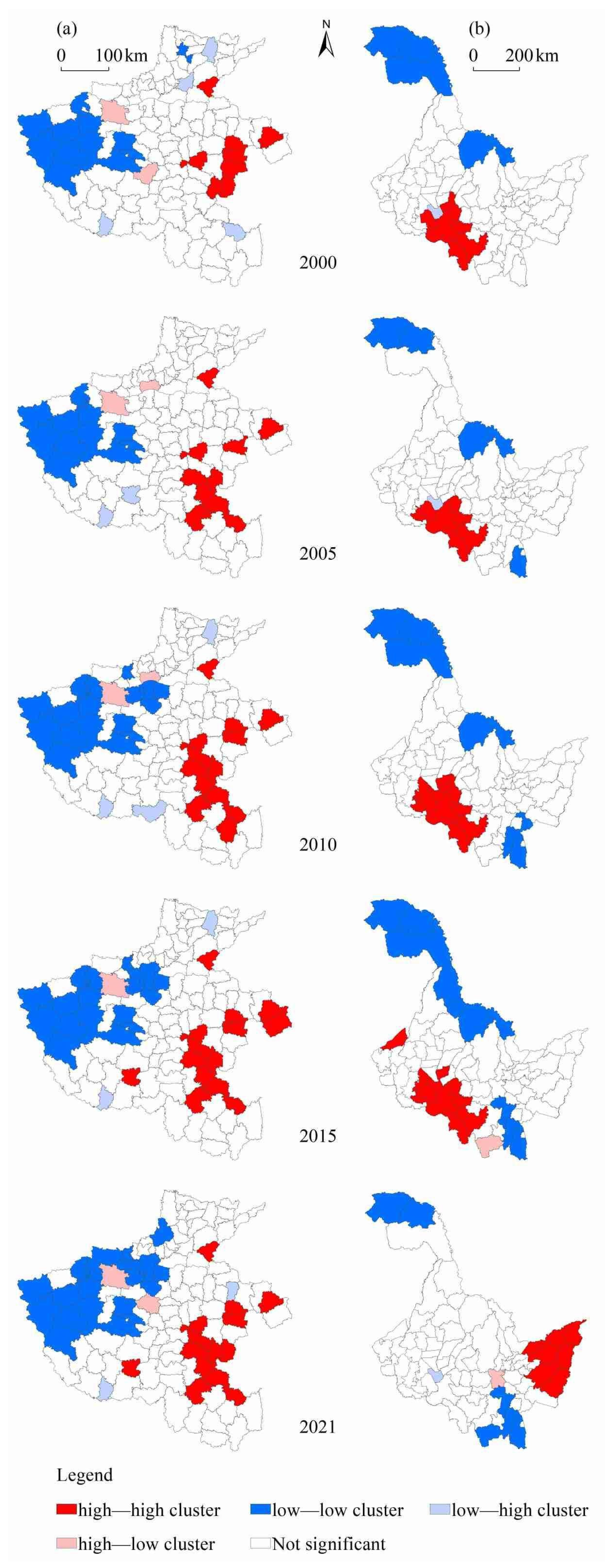
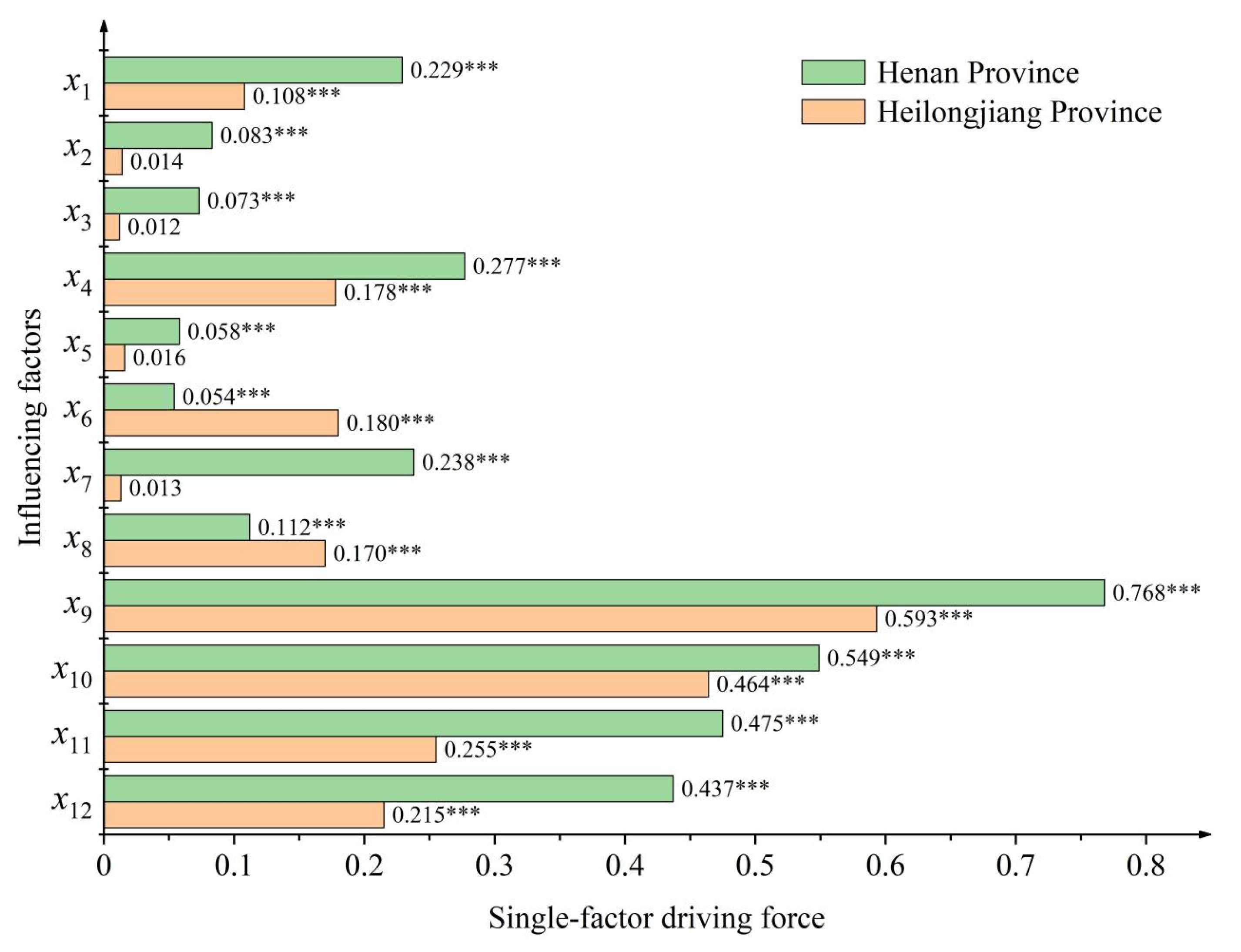
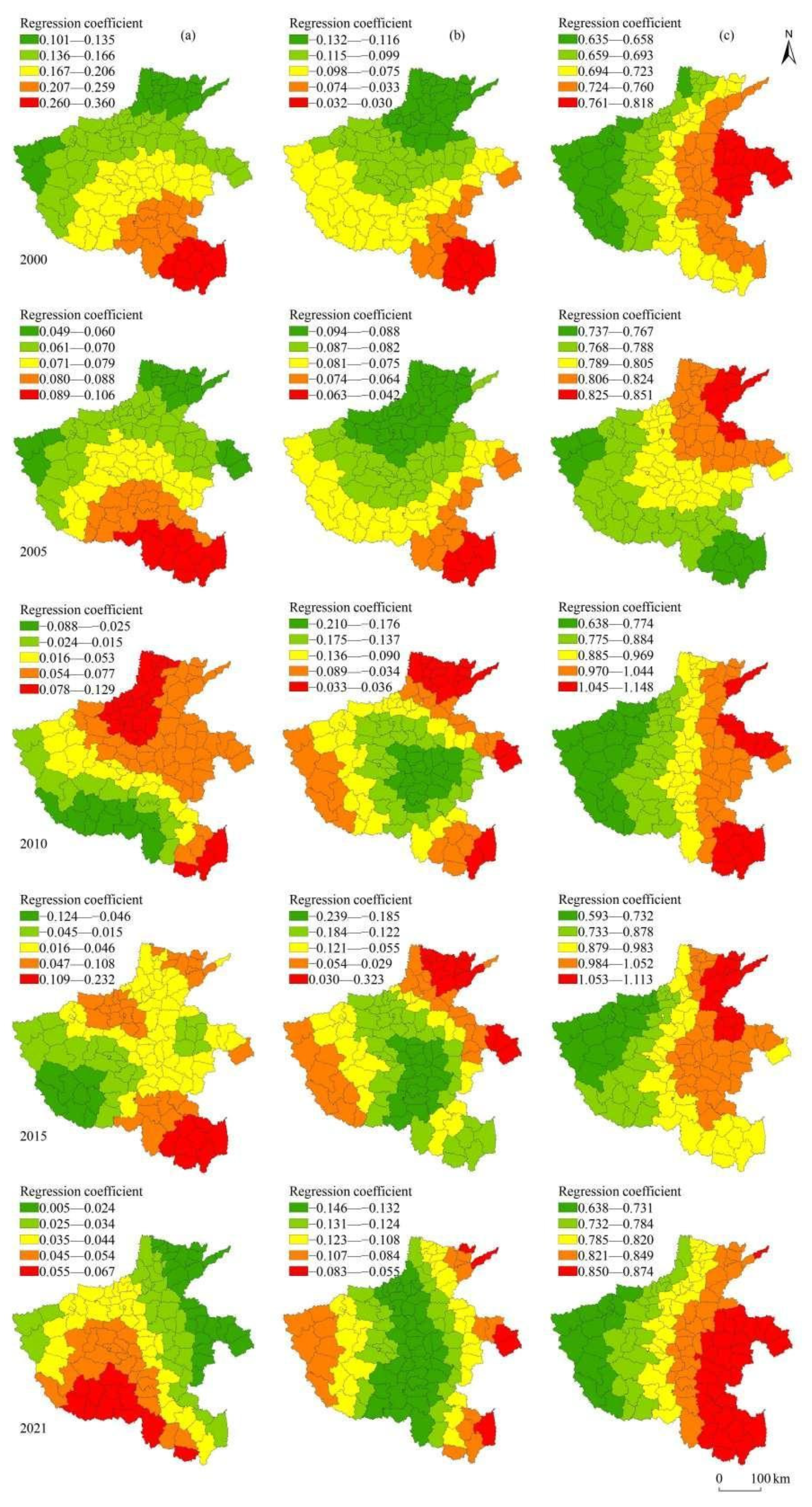
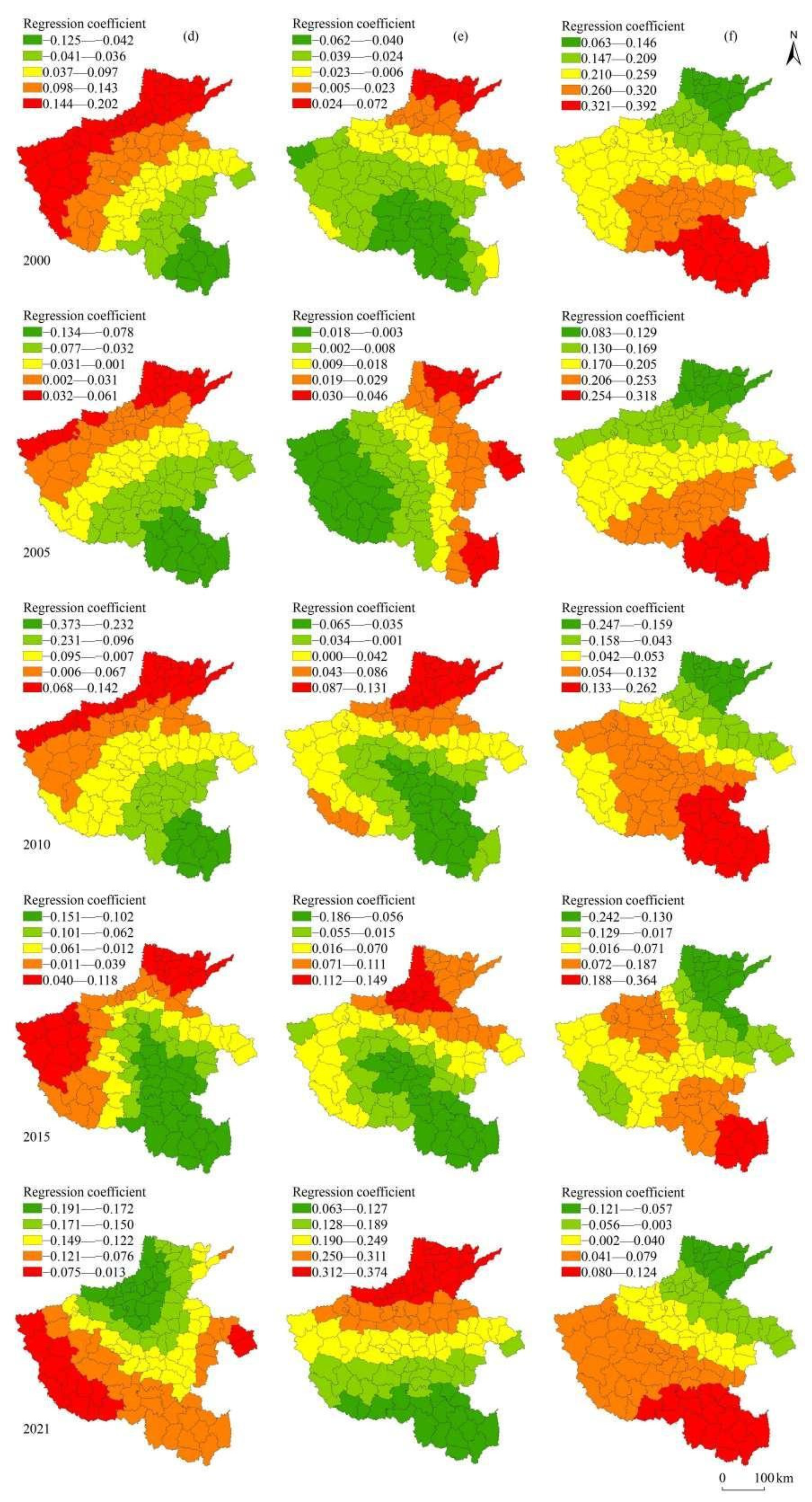
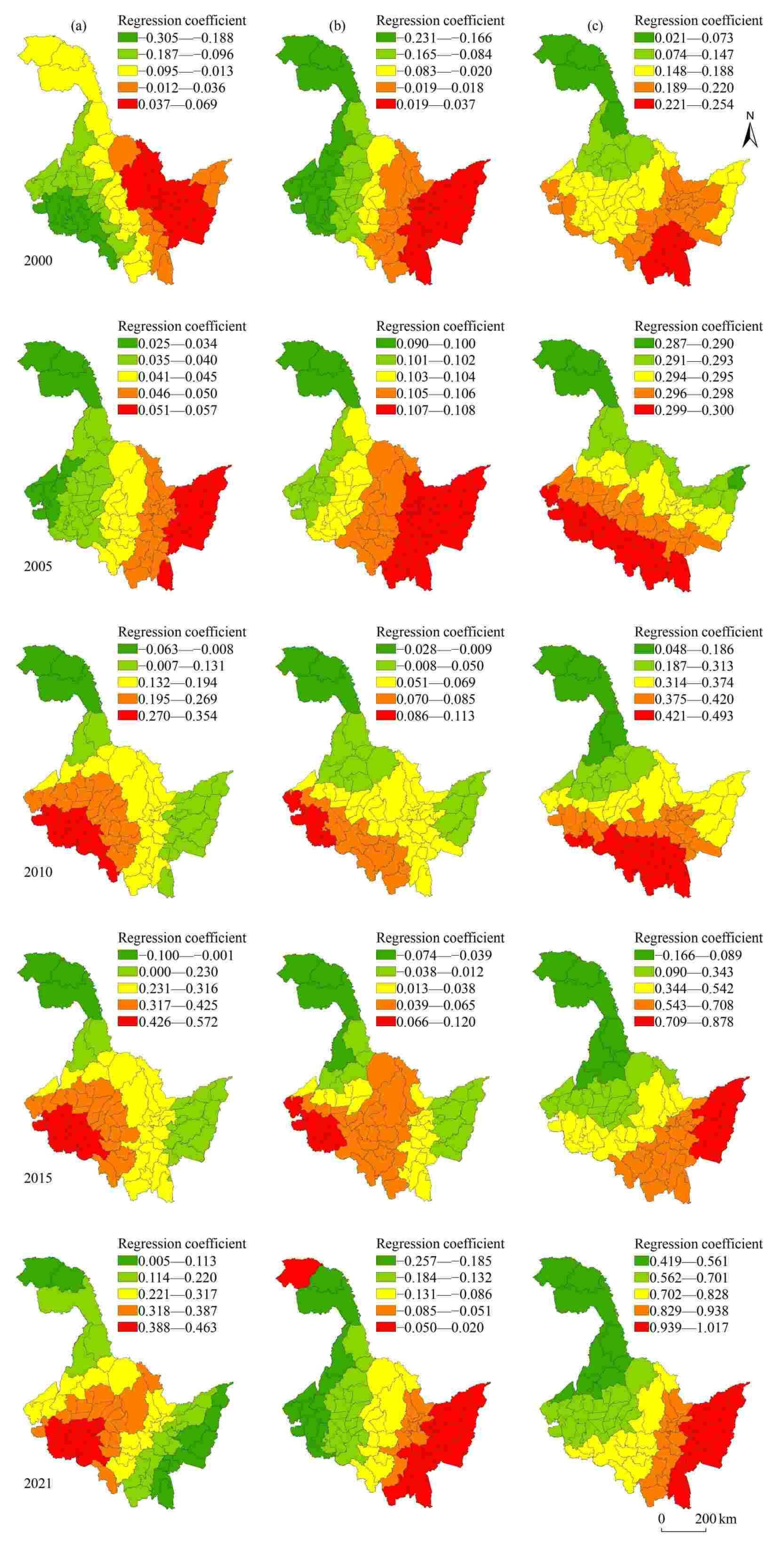
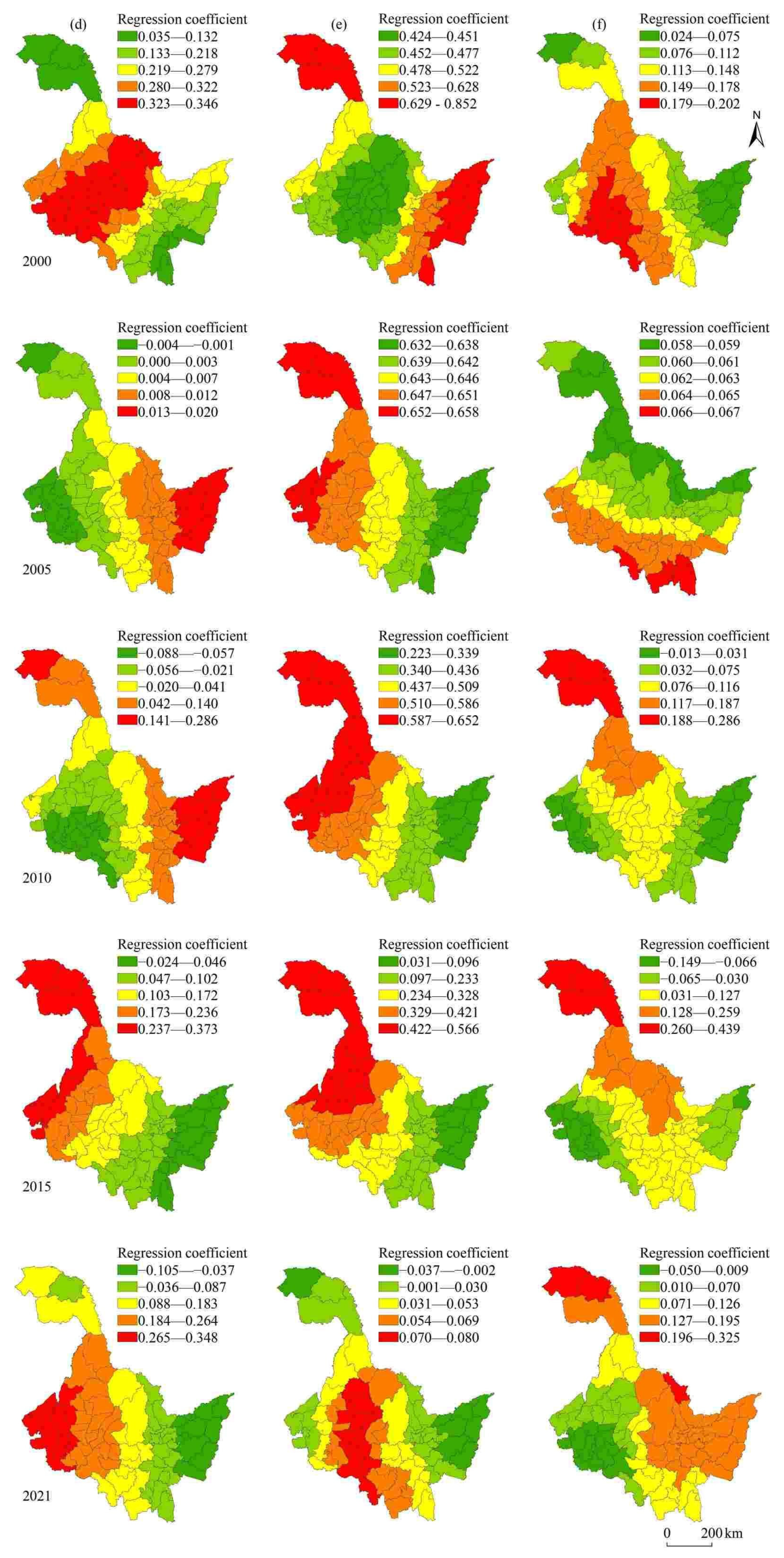
| Type | Indicator | Indicator Description | Unit |
|---|---|---|---|
| Geographical Environment Factors | Average Annual Temperature (x1) | Average temperature recorded annually | Celsius (°C) |
| Annual Precipitation (x2) | Total precipitation received annually | Millimeters (mm) | |
| Annual Sunshine Duration (x3) | Total hours of sunshine received annually | Hours | |
| Average Slope (x4) | Average slope of the terrain in the study area | Degree (%) | |
| Socio-economic Factors | Proportion of Agricultural Labor (x5) | Proportion of the agricultural labor force to the total population | Percentage (%) |
| GDP (x6) | Gross domestic product of the region | Currency (e.g., USD, CNY) | |
| Proportion of Primary Industry GDP (x7) | Proportion of the output value of the primary industry to GDP | Percentage (%) | |
| Per Capita Net Income of Farmers (x8) | Average income earned by farmers per capita | Currency (e.g., USD, CNY) | |
| Input Factors | Sown Area of Grain Crops (x9) | Total area dedicated to the cultivation of grain crops | Hectares (ha) |
| Total Agricultural Machinery Power (x10) | Combined power of all agricultural machinery in use | Kilowatts (kW) | |
| Pure Amount of Fertilizer Applied (x11) | Total amount of fertilizer applied | Metric Tons (MT) | |
| Effective Irrigation Area (x12) | Area of land effectively irrigated for crop cultivation | Hectares (ha) |
| District | Year | Standard Deviation Ellipse | |||||
|---|---|---|---|---|---|---|---|
| Area /km2 | Longitude (°E) | Latitude (°N) | Long/km | Short/km | Azimuth (°) | ||
| Henan | 2000 | 78,475.55 | 114.15 | 34.06 | 146.48 | 170.54 | 2.71 |
| 2005 | 78,627.02 | 114.16 | 33.99 | 145.51 | 172.00 | 6.95 | |
| 2010 | 79,322.38 | 114.18 | 33.97 | 144.73 | 174.46 | 5.43 | |
| 2015 | 78,655.41 | 114.19 | 33.97 | 144.32 | 173.49 | 8.12 | |
| 2021 | 77,341.12 | 114.20 | 33.98 | 142.82 | 172.38 | 11.54 | |
| Heilongjiang | 2000 | 154,627.52 | 127.69 | 46.56 | 284.10 | 173.26 | 104.60 |
| 2005 | 159,540.63 | 127.59 | 46.59 | 287.26 | 176.80 | 103.80 | |
| 2010 | 162,273.42 | 127.52 | 46.63 | 293.90 | 175.77 | 101.46 | |
| 2015 | 160,696.21 | 127.72 | 46.64 | 307.73 | 166.23 | 98.08 | |
| 2021 | 195,278.76 | 128.43 | 46.84 | 343.31 | 181.07 | 96.30 | |
| Year | Henan | Heilongjiang | ||||
|---|---|---|---|---|---|---|
| Moran’s I | Z | P | Moran’s I | Z | P | |
| 2000 | 0.346 | 5.390 | 0.001 | 0.322 | 4.964 | 0.005 |
| 2001 | 0.418 | 6.420 | 0.001 | 0.280 | 4.419 | 0.004 |
| 2002 | 0.413 | 6.281 | 0.001 | 0.350 | 5.428 | 0.001 |
| 2003 | 0.221 | 3.521 | 0.002 | 0.379 | 5.986 | 0.004 |
| 2004 | 0.367 | 5.760 | 0.001 | 0.344 | 5.272 | 0.001 |
| 2005 | 0.361 | 5.648 | 0.001 | 0.348 | 5.293 | 0.001 |
| 2006 | 0.375 | 5.892 | 0.001 | 0.379 | 5.523 | 0.001 |
| 2007 | 0.382 | 5.994 | 0.001 | 0.392 | 5.737 | 0.001 |
| 2008 | 0.402 | 6.306 | 0.001 | 0.375 | 5.455 | 0.001 |
| 2009 | 0.421 | 6.589 | 0.001 | 0.361 | 5.300 | 0.001 |
| 2010 | 0.427 | 6.670 | 0.001 | 0.380 | 5.529 | 0.001 |
| 2011 | 0.440 | 6.860 | 0.001 | 0.355 | 5.127 | 0.001 |
| 2012 | 0.440 | 6.846 | 0.001 | 0.316 | 4.537 | 0.001 |
| 2013 | 0.456 | 7.115 | 0.001 | 0.343 | 4.951 | 0.001 |
| 2014 | 0.465 | 7.233 | 0.001 | 0.353 | 5.106 | 0.001 |
| 2015 | 0.439 | 6.848 | 0.001 | 0.391 | 5.553 | 0.001 |
| 2016 | 0.449 | 7.021 | 0.001 | 0.376 | 5.325 | 0.001 |
| 2017 | 0.466 | 7.360 | 0.001 | 0.380 | 5.442 | 0.001 |
| 2018 | 0.456 | 7.203 | 0.001 | 0.341 | 4.887 | 0.001 |
| 2019 | 0.444 | 6.906 | 0.001 | 0.405 | 5.675 | 0.001 |
| 2020 | 0.475 | 7.446 | 0.001 | 0.417 | 5.840 | 0.001 |
| 2021 | 0.438 | 6.955 | 0.001 | 0.415 | 5.801 | 0.001 |
| Dependent Variable | 2000 | 2005 | 2010 | 2015 | 2021 | |||||
|---|---|---|---|---|---|---|---|---|---|---|
| Regression Coefficient | VIF | R | VIF | Regression Coefficient | VIF | Regression Coefficient | VIF | Regression Coefficient | VIF | |
| x3 | 0.133 *** | 1.587 | 0.064 *** | 1.353 | 0.042 ** | 1.132 | 0.031 * | 1.375 | 0.021 * | 1.183 |
| x4 | −0.084 ** | 1.620 | −0.068 *** | 1.621 | −0.131 *** | 1.331 | −0.124 *** | 1.421 | −0.117 *** | 1.356 |
| x9 | 0.718 *** | 4.588 | 0.787 *** | 4.966 | 0.887 *** | 4.340 | 0.878 *** | 4.967 | 0.792 *** | 6.624 |
| x10 | 0.107 ** | 2.612 | −0.028 * | 2.949 | −0.093 ** | 3.528 | −0.072 * | 4.168 | −0.134 *** | 4.329 |
| x11 | −0.059 * | 4.265 | 0.002 * | 3.137 | 0.042 * | 3.316 | 0.060 * | 3.264 | 0.233 *** | 3.639 |
| x12 | 0.263 *** | 3.446 | 0.224 *** | 4.106 | 0.098 *** | 1.998 | 0.092 *** | 1.952 | 0.037 * | 1.886 |
| F | 183.293 *** | 350.860 *** | 294.624 *** | 422.691 *** | 257.129 *** | |||||
| Koenker | 10.899 * | 16.309 ** | 14.910 ** | 18.341 *** | 13.950 ** | |||||
| AICc | 72.046 | −0.407 | 19.394 | −21.714 | 34.682 | |||||
| R2 | 0.907 | 0.949 | 0.940 | 0.957 | 0.932 | |||||
| Adj R2 | 0.902 | 0.946 | 0.937 | 0.955 | 0.928 | |||||
| Dependent Variable | 2000 | 2005 | 2010 | 2015 | 2021 | |||||
|---|---|---|---|---|---|---|---|---|---|---|
| Regression Coefficient | VIF | Regression Coefficient | VIF | Regression Coefficient | VIF | Regression Coefficient | VIF | Regression Coefficient | VIF | |
| x1 | −0.045 * | 1.252 | 0.039 * | 1.230 | 0.107 ** | 1.286 | 0.153 *** | 1.274 | 0.137 ** | 1.263 |
| x8 | −0.015 * | 1.117 | 0.104 *** | 1.099 | 0.058 * | 1.061 | 0.023 * | 1.024 | −0.086 *** | 1.135 |
| x9 | 0.130 * | 3.370 | 0.294 *** | 4.102 | 0.271 *** | 3.554 | 0.213 ** | 3.394 | 0.683 *** | 1.897 |
| x10 | 0.330 *** | 4.110 | 0.003 * | 4.003 | 0.064 * | 4.382 | 0.206 ** | 4.020 | 0.150 ** | 2.085 |
| x11 | 0.485 *** | 4.918 | 0.650 *** | 4.631 | 0.558 *** | 4.149 | 0.415 *** | 3.493 | 0.036 * | 1.085 |
| x12 | 0.106 ** | 1.473 | 0.056 * | 1.530 | 0.064 * | 1.734 | 0.125 ** | 1.909 | 0.205 *** | 1.677 |
| F | 81.332 *** | 157.552 *** | 73.562 *** | 70.794 *** | 102.005 *** | |||||
| Koenker | 22.030 *** | 12.057 * | 12.120 * | 15.713 ** | 33.514 *** | |||||
| AICc | 72.422 | 27.406 | 78.991 | 81.476 | 57.319 | |||||
| R2 | 0.878 | 0.933 | 0.867 | 0.862 | 0.900 | |||||
| Adj R2 | 0.867 | 0.927 | 0.855 | 0.850 | 0.891 | |||||
| 2000 | 2005 | 2010 | 2015 | 2021 | |
|---|---|---|---|---|---|
| Bandwidth | 202,826.487 | 247,709.211 | 133,818.278 | 106,874.926 | 190,312.857 |
| Residual Squares | 8.659 | 5.117 | 3.065 | 1.571 | 6.303 |
| Effective Number | 19.256 | 15.464 | 33.106 | 43.728 | 20.830 |
| Sigma | 0.293 | 0.221 | 0.188 | 0.144 | 0.252 |
| AICc | 61.716 | −8.297 | −31.641 | −79.357 | 26.825 |
| R2 | 0.927 | 0.957 | 0.974 | 0.987 | 0.947 |
| Adjusted R2 | 0.914 | 0.951 | 0.965 | 0.979 | 0.936 |
| 2000 | 2005 | 2010 | 2015 | 2021 | |
|---|---|---|---|---|---|
| Bandwidth | 3.163 | 13.813 | 3.848 | 2.933 | 2.884 |
| Residual Squares | 5.393 | 4.842 | 7.122 | 5.097 | 2.059 |
| Effective Number | 20.881 | 8.260 | 18.178 | 24.233 | 22.821 |
| Sigma | 0.316 | 0.269 | 0.354 | 0.317 | 0.199 |
| AICc | 62.316 | 27.233 | 76.019 | 67.577 | −4.303 |
| R2 | 0.927 | 0.935 | 0.904 | 0.931 | 0.972 |
| Adjusted R2 | 0.900 | 0.927 | 0.875 | 0.900 | 0.961 |
Disclaimer/Publisher’s Note: The statements, opinions and data contained in all publications are solely those of the individual author(s) and contributor(s) and not of MDPI and/or the editor(s). MDPI and/or the editor(s) disclaim responsibility for any injury to people or property resulting from any ideas, methods, instructions or products referred to in the content. |
© 2023 by the authors. Licensee MDPI, Basel, Switzerland. This article is an open access article distributed under the terms and conditions of the Creative Commons Attribution (CC BY) license (https://creativecommons.org/licenses/by/4.0/).
Share and Cite
Wang, Z.; Zhang, E.; Chen, G. Spatiotemporal Variation and Influencing Factors of Grain Yield in Major Grain-Producing Counties: A Comparative Study of Two Provinces from China. Land 2023, 12, 1810. https://doi.org/10.3390/land12091810
Wang Z, Zhang E, Chen G. Spatiotemporal Variation and Influencing Factors of Grain Yield in Major Grain-Producing Counties: A Comparative Study of Two Provinces from China. Land. 2023; 12(9):1810. https://doi.org/10.3390/land12091810
Chicago/Turabian StyleWang, Zhipeng, Ershen Zhang, and Guojun Chen. 2023. "Spatiotemporal Variation and Influencing Factors of Grain Yield in Major Grain-Producing Counties: A Comparative Study of Two Provinces from China" Land 12, no. 9: 1810. https://doi.org/10.3390/land12091810
APA StyleWang, Z., Zhang, E., & Chen, G. (2023). Spatiotemporal Variation and Influencing Factors of Grain Yield in Major Grain-Producing Counties: A Comparative Study of Two Provinces from China. Land, 12(9), 1810. https://doi.org/10.3390/land12091810








